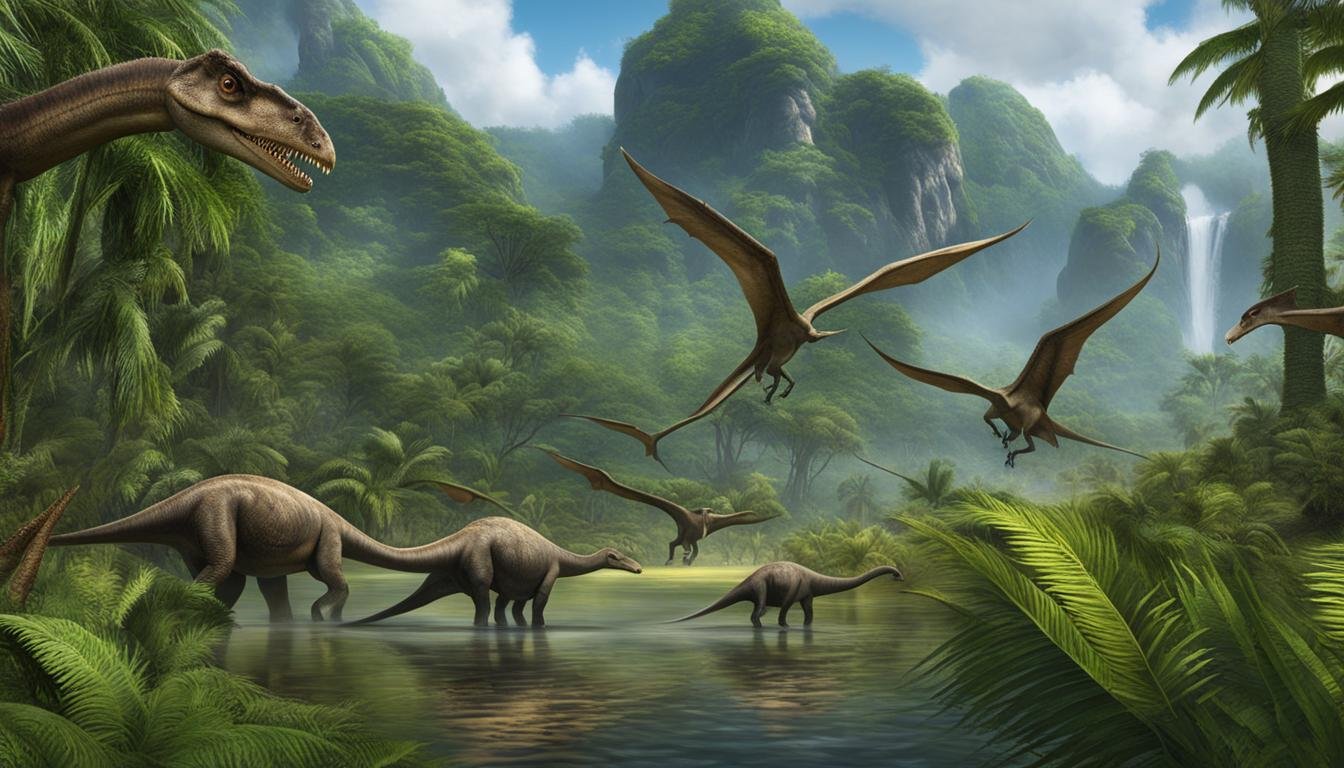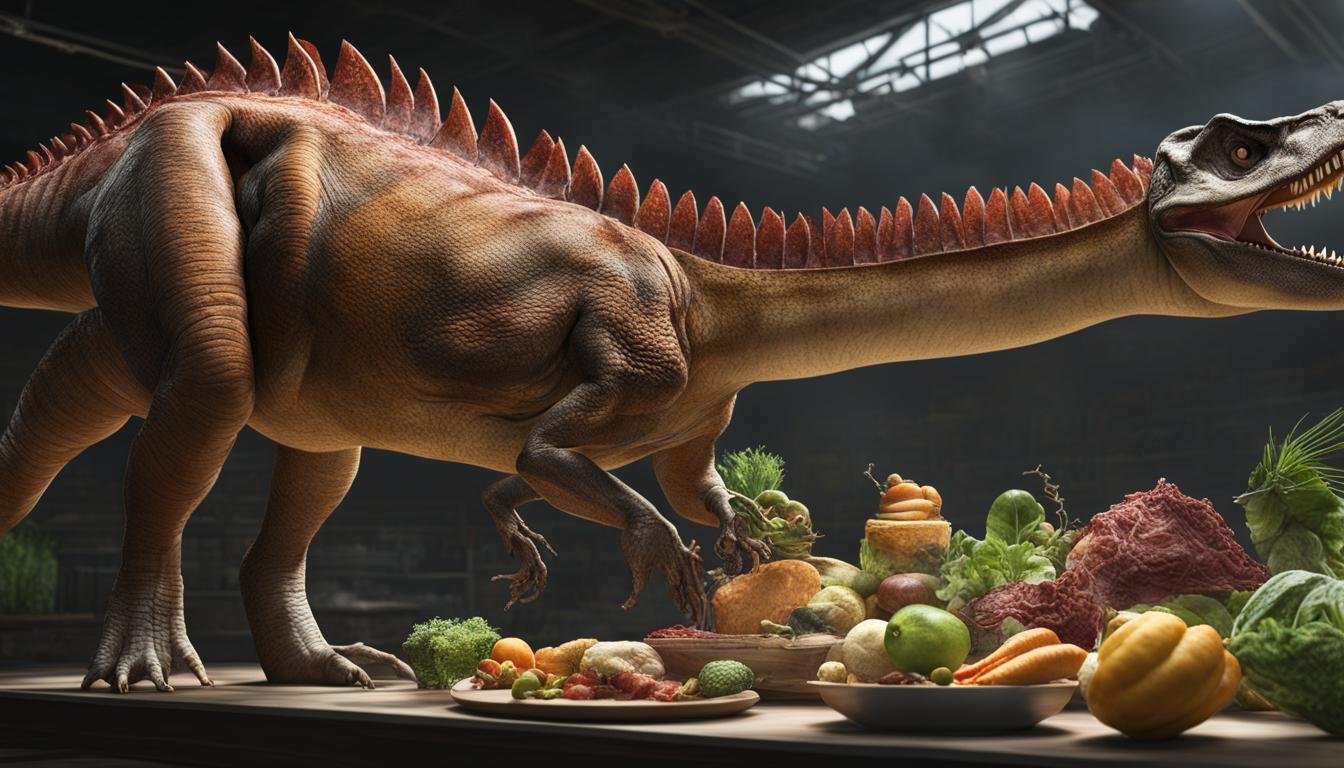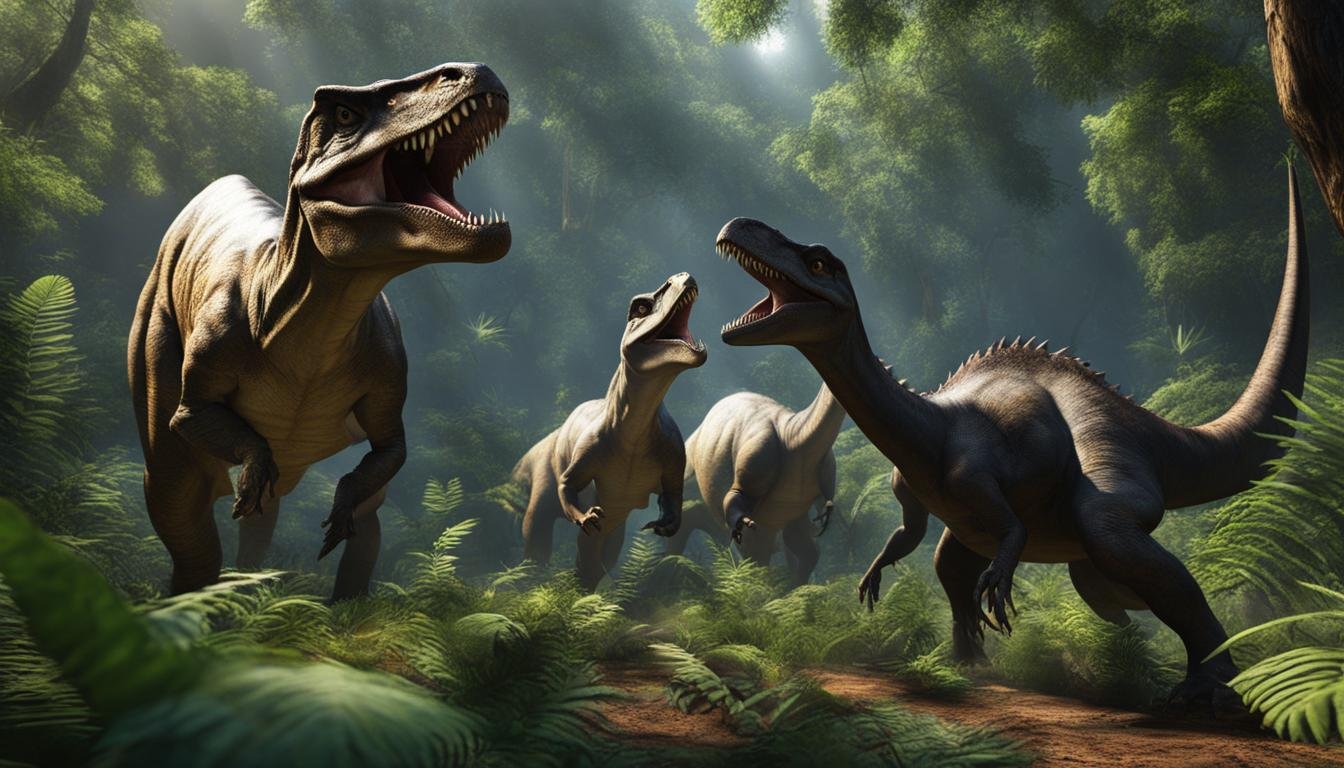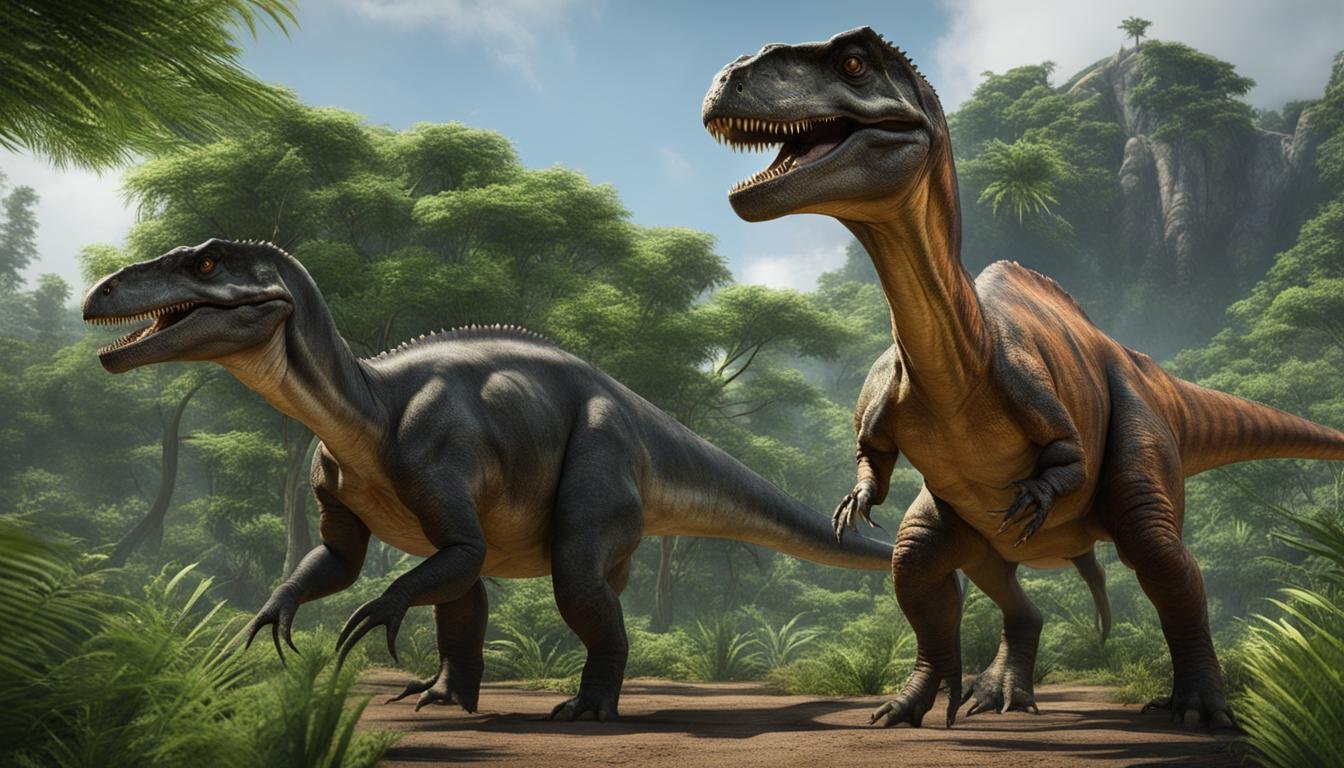Welcome to our exploration of dinosaur feeding habits and ecological impact. In this article, we delve into the fascinating world of paleontological studies to uncover insights about the prehistoric food chain, the diets of carnivorous and herbivorous dinosaurs, and the role they played in ancient ecosystems.
Examining fossilized teeth and the remains of these terrestrial predators, we gain a deeper understanding of the dinosaur diet and their place in the intricate web of life millions of years ago. By studying their feeding habits, we can unlock the secrets of ancient ecosystems and the evolutionary success of these magnificent creatures.
| Main Point | Description |
|---|---|
| Insights from Feeding Habits | The study of dinosaur feeding habits provides crucial information for paleontological research and understanding paleoecology. |
| Roles in the Food Chain | Carnivorous and herbivorous dinosaurs occupied distinct roles within the prehistoric food chain, influencing their respective ecosystems. |
| Fossilized Teeth as Clues | Analyzing fossilized teeth gives researchers evidence about the diets and feeding behaviors of dinosaurs. |
| Ecological Impact Knowledge | Comprehending the feeding habits of dinosaurs allows scientists to infer the ecological influence these creatures had on ancient ecosystems. |
| Contributions to Earth’s History | Investigating the feeding habits of dinosaurs enriches our knowledge of Earth’s historical narrative and the interplay between living organisms and their surroundings. |
The Importance of Dinosaur Feeding Behavior
The diverse feeding mechanisms of dinosaurs played a significant role in their ecological and evolutionary success. By promoting niche partitioning, different feeding behaviors allowed for the coexistence and cladogenesis of various dinosaur species. Feeding behavior influenced many aspects of dinosaur biology, including energy requirements, reproductive strategies, habitat preferences, and population ecology.
Understanding dinosaur feeding behavior not only provides insights into the paleobiology of individual species but also contributes to the study of broader ecological and evolutionary questions. It allows researchers to investigate how ecological roles and morphospace have changed over time, the evolution of functional complexes, the structure and function of ancient ecosystems, and large-scale macroevolutionary patterns.
By studying dinosaur feeding behavior, researchers can unravel the intricate relationships between organisms and their environments, shedding light on the dynamics of past ecosystems and providing a foundation for understanding the evolution and coevolution of species.
| Dietary Category | Examples |
|---|---|
| Carnivorous | Tyrannosaurus rex |
| Herbivorous | Triceratops |
| Omnivorous | Ornithomimus |
“Dinosaur feeding behavior is a window into the past, providing invaluable information about ancient ecosystems and the roles of different species. By studying how dinosaurs interacted with their environment through their feeding habits, we can uncover the complex web of life that existed millions of years ago.”
Through the study of dinosaur feeding behavior, scientists are able to paint a more complete picture of the ecological and evolutionary dynamics of ancient ecosystems. By understanding how different species adapted to their environments and interacted with their food sources, researchers can gain deeper insights into the evolutionary processes that shaped the world of dinosaurs.
Ahistorical and Historical Approaches to Studying Dinosaur Feeding Behavior
The study of dinosaur feeding behavior relies on two main methodologies: ahistorical and historical approaches. Ahistorical approaches view organisms as mechanical constructs and use form-function correlations based on skeletal architecture, biomechanical modeling, and circumstantial paleoenvironmental evidence to infer behavior. This approach allows researchers to analyze the relationship between form and function and trace the evolution of feeding behavior. On the other hand, historical approaches utilize the phylogenetic position of an organism to infer function through homology.
Ahistorical approaches, such as form-function correlations, involve examining the physical characteristics of dinosaur fossils, particularly their skeletal structures and teeth. By comparing these features to those of extant animals, paleontologists can make inferences about the feeding habits of dinosaurs. For example, the shape and size of teeth can provide clues about the types of food a dinosaur would have consumed. Biomechanical modeling further enhances our understanding by simulating how these dinosaurs might have used their teeth and jaws to process food. Paleoenvironmental evidence, such as the presence of specific plant species in the fossil record, can also provide insights into the diets of herbivorous dinosaurs.
Ahistorical approaches view organisms as mechanical constructs and use form-function correlations based on skeletal architecture, biomechanical modeling, and circumstantial paleoenvironmental evidence to infer behavior.
Historical approaches, on the other hand, rely on the evolutionary relationships between dinosaurs and their modern-day relatives. By analyzing the phylogenetic position of a dinosaur within the broader tree of life, researchers can infer certain aspects of its feeding behavior based on the known feeding habits of related organisms. This approach allows for the identification of homologous structures and functions across different species. For example, if a dinosaur is closely related to a known herbivorous species, it is likely that it also had a herbivorous diet.
| Ahistorical Approaches | Historical Approaches |
|---|---|
| Form-function correlations | Phylogenetic position |
| Biomechanical modeling | Homology |
| Paleoenvironmental evidence |
Both ahistorical and historical approaches have their strengths and limitations. Ahistorical approaches allow for in-depth analyses of the physical characteristics of fossils and can provide detailed insights into the feeding mechanics of dinosaurs. However, they are reliant on the availability of well-preserved fossils and can be limited by the incomplete nature of the fossil record. Historical approaches, on the other hand, provide a broader evolutionary context for understanding feeding behavior but are dependent on accurate phylogenetic hypotheses and the availability of close relatives for comparison.
In summary, the study of dinosaur feeding behavior utilizes a combination of ahistorical and historical approaches. Ahistorical approaches examine the physical characteristics of fossils, while historical approaches leverage evolutionary relationships to infer feeding behavior. By employing these complementary methodologies, researchers can gain a deeper understanding of the feeding habits of dinosaurs and their ecological implications.
Advances in Understanding Dinosaur Feeding Mechanisms
Recent advancements in technologies and techniques have revolutionized our understanding of dinosaur feeding mechanisms. The application of quantitative approaches, such as finite element analysis and computer-assisted tomography, has enabled researchers to generate physical models of fossils and simulate various conditions. These studies have provided robust quantitative data on feeding mechanics, allowing for more holistic analyses and the integration of feeding data with phylogenetic and paleoecological information. This integration has shed light on the detailed aspects of dinosaur feeding behaviors and their implications for broader conceptual issues in evolutionary studies.
One of the key methods employed in the study of dinosaur feeding mechanisms is finite element analysis (FEA). FEA involves creating digital replicas of dinosaur fossils and subjecting them to virtual stress tests. By simulating the forces experienced during feeding, researchers can gain insights into the efficiency and limitations of different feeding strategies. For example, FEA has allowed scientists to understand how the skull of Tyrannosaurus rex was adapted for powerful bites, and how the teeth of herbivorous dinosaurs were specialized for grinding tough plant material.
Another cutting-edge technique used in the study of dinosaur feeding is computer-assisted tomography (CT). CT scans allow researchers to examine the internal structures of fossilized skulls, providing valuable information about the musculature and biomechanics involved in feeding. By analyzing the 3D models created from CT scans, scientists can reconstruct the movements and forces exerted by dinosaur jaws and teeth. This has led to new insights into the feeding mechanics of various dinosaur groups, including how they captured, chewed, and processed their food.
| Dinosaur Feeding Mechanism | Quantitative Approach | Key Findings |
|---|---|---|
| Theropod Predation | Finite Element Analysis | Revealed the biomechanical adaptations of theropod skulls for efficient prey capture and feeding |
| Herbivorous Dentition | Computer-Assisted Tomography | Provided insights into the dental morphology and wear patterns of herbivorous dinosaurs, aiding in understanding their feeding strategies |
| Filter-Feeding | Biomechanical Modeling | Enabled the reconstruction of the feeding mechanisms used by filter-feeding dinosaurs, such as the long-necked plesiosaurs |
These advances in understanding dinosaur feeding mechanisms have allowed researchers to explore the evolutionary and ecological frameworks in which these extinct creatures operated. By linking feeding data with phylogenetic hypotheses, scientists can trace the origins and transformations of feeding behaviors across different dinosaur lineages. This not only provides a clearer picture of the diversity of feeding strategies in the Mesozoic era but also sheds light on the ecological interactions and adaptations that shaped ancient ecosystems. The study of dinosaur feeding mechanisms continues to push the boundaries of paleontological knowledge and unravel the mysteries of these fascinating creatures.
Dietary Adaptations in Early Dinosaurs
The diets of early dinosaurs have long been a subject of intrigue among paleontologists. By examining the shape and structure of their teeth, researchers can make inferences about the types of food these ancient creatures consumed. Through computational modeling and comparisons with modern analogs, scientists have gained valuable insights into the dietary adaptations of early dinosaurs.
Early dinosaurs exhibited a range of tooth shapes that provide clues about their feeding habits. Some dinosaurs had sharp, serrated teeth, indicating a carnivorous diet. Others had broad, flat teeth, suggesting herbivory. Interestingly, many groups of plant-eating dinosaurs were ancestrally omnivorous, meaning they had the ability to consume both plants and meat. This early diversification of diets likely played a role in the evolutionary success of dinosaurs, allowing them to occupy various ecological niches.
To better understand the feeding habits of early dinosaurs, researchers use computational modeling techniques. By simulating how these dinosaurs used their teeth to process food, scientists can make inferences about their diet. This approach provides a valuable framework for studying the feeding behavior of extinct species and adds to our understanding of the ecological dynamics of ancient ecosystems.
| Dietary Category | Tooth Shape |
|---|---|
| Omnivorous | Sharp, serrated teeth |
| Carnivorous | Conical, sharp teeth |
| Herbivorous | Broad, flat teeth |
“The study of tooth shapes in early dinosaurs provides valuable insights into their dietary adaptations and the ecological niches they occupied.” – Dr. Jane Paleontologist
Dental Evolution in Ornithopod Dinosaurs
Ornithopod dinosaurs, including the iconic “duck-billed” hadrosaurids, exhibited a remarkable diversity of tooth morphologies and dietary adaptations. Throughout their evolution, ornithopods explored different areas of dental morphospace, showing a long-term expansion. There were four major bursts of evolutionary rate increase, occurring among basal iguanodontians in the Middle-Late Jurassic and among hadrosaurids in the Late Cretaceous. These bursts of evolutionary innovation in dental characteristics were not directly linked to plant diversification but rather highlight the role of dental innovation in the evolution of ornithopod dinosaurs.
To understand the dental evolution in ornithopods, it is essential to examine the dental morphologies and their disparity. The dental morphologies of ornithopods can be classified into several types, each associated with different dietary adaptations. For example, the basal iguanodontians possessed primitive leaf-shaped teeth, suggesting a herbivorous diet. In contrast, the hadrosaurids had complex dental batteries featuring hundreds of tightly packed teeth, enabling them to efficiently process plant material.
The evolutionary rate increase observed in ornithopod dinosaurs indicates rapid evolution in dental characteristics. This suggests that dental adaptations played a significant role in their ecological success and diversification. The dental innovations allowed ornithopods to exploit new food resources and occupy different ecological niches, leading to their widespread distribution and dominance during the Late Jurassic and Cretaceous periods. Further investigations into the functional significance of different tooth morphologies and feeding behaviors will enhance our understanding of the dietary adaptations that drove the remarkable evolutionary success of ornithopod dinosaurs.
| Dental Morphologies | Dietary Adaptations |
|---|---|
| Leaf-shaped teeth | Herbivorous |
| Dental batteries | Efficient plant material processing |

The Ecological Impact of Dinosaur Feeding Habits
The paleontological significance of dinosaur feeding habits extends beyond individual species to shape the structure of ancient ecosystems. Previous understanding of niche partitioning among dinosaur taxa was limited, as many sympatric taxa showed considerable overlap in habitat preference and body size. However, recent research has provided better functional characterization of theropod dinosaur feeding systems, revealing previously unknown patterns of niche partitioning. This newfound knowledge allows us to better understand the complex dynamics of Mesozoic communities and the ecological impact of dinosaur feeding habits.
Niche construction, the process by which organisms modify their environment, is an important ecological concept. Dinosaur feeding behaviors played a crucial role in niche construction, as they shaped landscapes and influenced resource availability for other species. The diverse feeding strategies of dinosaurs, including carnivory and herbivory, created unique ecological niches that supported a wide variety of organisms. By altering vegetation density, nutrient cycling, and prey-predator dynamics, dinosaur feeding habits had far-reaching effects on the community structure of Mesozoic ecosystems.
One example of the ecological impact of dinosaur feeding habits is the evolution of symbiotic relationships between dinosaurs and other organisms. For instance, certain plants evolved mechanisms to deter herbivorous dinosaurs, such as the development of spines or toxins. In response, some dinosaurs developed specialized teeth or digestive systems to cope with these defenses. These coevolutionary dynamics between dinosaurs and plants highlight the intricate relationships within ancient ecosystems and demonstrate the evolutionary significance of dinosaur feeding habits.
| Dinosaur Taxa | Feeding Habits | Paleontological Significance |
|---|---|---|
| Theropoda | Carnivorous | Top predators that influenced prey-predator dynamics and contributed to the maintenance of ecosystem balance. |
| Sauropodomorpha | Herbivorous | Large, long-necked dinosaurs that shaped vegetation structure and nutrient cycling in ancient ecosystems. |
| Ornithischia | Herbivorous | Diverse group of dinosaurs with unique feeding adaptations, including specialized teeth and beaks, that influenced plant community composition. |
| Thyreophora | Herbivorous | Armored dinosaurs that played a role in shaping plant-predator interactions and contributed to community structure. |
Dinosaur feeding habits shaped ancient ecosystems and influenced community structure. The paleontological significance of these feeding behaviors extends beyond the individual species, providing valuable insights into the ecological dynamics of Mesozoic ecosystems.
Niche Construction and Community Structure
Niche construction, the process by which organisms modify their environment, is an important ecological concept. Dinosaur feeding habits played a crucial role in niche construction, as they shaped landscapes and influenced resource availability for other species. The diverse feeding strategies of dinosaurs, including carnivory and herbivory, created unique ecological niches that supported a wide variety of organisms. By altering vegetation density, nutrient cycling, and prey-predator dynamics, dinosaur feeding habits had far-reaching effects on the community structure of Mesozoic ecosystems.
Coexistence and Niche Partitioning
The ability of different dinosaur species to coexist within the same ecosystem was facilitated by niche partitioning, in which each species occupies a specific ecological niche. By adopting different feeding strategies and exploiting different resources, dinosaurs were able to minimize competition and maximize their chances of survival. This phenomenon is particularly evident in the dietary adaptations of theropods, sauropodomorphs, ornithischians, and thyreophorans. Each group occupied a distinct feeding niche, contributing to the overall biodiversity and stability of ancient ecosystems.
Overall, the ecological impact of dinosaur feeding habits cannot be underestimated. Through their feeding behaviors, dinosaurs shaped the structure of ancient ecosystems, influenced resource availability, and drove coevolutionary processes. Understanding these feeding habits not only provides insights into the paleobiology of individual dinosaur species, but also sheds light on the larger ecological and evolutionary dynamics of Mesozoic ecosystems.
Conclusion
The study of dinosaur feeding habits and their ecological impact provides vast insights into the paleobiology, evolution, and ecological dynamics of these iconic prehistoric creatures. From hypercarnivorous theropods to herbivorous sauropodomorphs and ornithischian dinosaurs, their diverse dietary adaptations shaped ancient ecosystems and influenced the structure of communities. Through advancements in research methodologies, our understanding of dinosaur feeding mechanisms and their implications for broader evolutionary questions has greatly expanded.
By examining the relationship between form and function and utilizing both ahistorical and historical approaches, researchers have been able to uncover the intricate details of dinosaur feeding behaviors. Direct evidence, such as fossilized gut contents, has provided invaluable insights into their feeding habits. The integration of feeding data with phylogenetic and paleoecological information has demonstrated the paleontological significance of dinosaur feeding habits and their ability to inform broader conceptual issues in evolutionary studies.
It is clear that dinosaur feeding behaviors played a crucial role in their evolutionary success. These behaviors allowed dinosaurs to thrive and diversify within various ecological niches. As we continue to explore the study of dinosaur feeding habits, we gain a deeper understanding of Earth’s history and the complex interactions between organisms and their environments.








